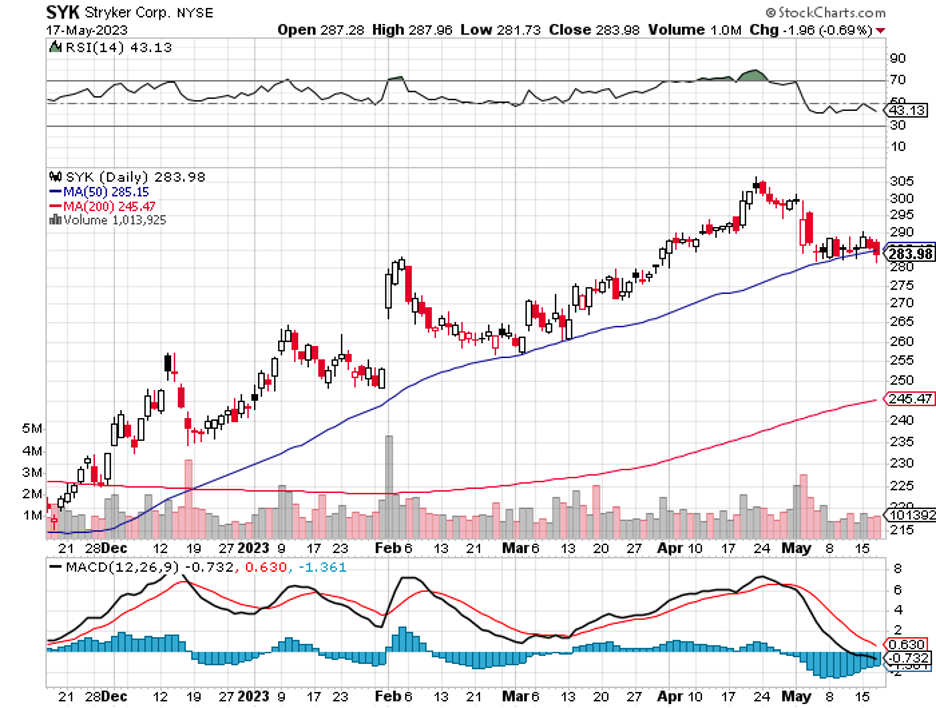As this bear market lingers, my attention keeps gravitating toward healthcare and insurance stocks.
Why, you ask? Well, let me break it down for you into three compelling points that make them enticing options for investors, especially when the market isn't at its finest.
First, there's the allure of steady demand. You see, healthcare insurance isn't just a luxury or a fleeting trend—it's a necessity. No matter the economic landscape, people will always require healthcare services, ensuring a consistent demand. And when it comes to investing, stability, and predictability are music to my ears. I mean, who doesn't appreciate a good dose of stability and predictability?
Second is the potential for growth. As the American population continues to age and healthcare costs skyrocket, the need for reliable healthcare insurance providers becomes more pronounced. It's like witnessing a golden opportunity for growth unfold right before our eyes. While I typically lean towards income-focused investments, the idea of capitalizing on an industry that has growth potential when others are merely treading water? Well, that's quite appealing, isn't it?
Third is its resilience to economic downturns. This one's a game-changer. When the economy takes a nosedive, people tighten their belts and cut back on discretionary spending. However, healthcare is an area where they're reluctant to compromise. It takes precedence. So, even in the face of economic turmoil, healthcare insurance providers remain steadfast. They possess an inherent ability to weather the storm and come out stronger. And let me tell you, that's the kind of resilience that can truly make a difference in your investment portfolio.
A promising contender in my search for long-term healthcare stocks is Stryker Corporation (SYK).
With a market capitalization of $113 billion, it ranks second globally, just behind Medtronic (MDT). Established in 1941, Stryker is a leading technology company specializing in the development and production of medical devices and equipment. Operating across multiple healthcare niches, Stryker holds a prominent position as one of the world's largest medical technology firms, focusing on three niches.
One is orthopedics, where the company focuses on the creation of devices for joint replacement, trauma care, spinal repair, and complementary surgical instruments.
Another is the MedSurg segment, which specializes in the development and manufacturing of medical and surgical equipment, encompassing endoscopic and imaging systems, as well as powered surgical tools.
The last is its Neurotechnology and Spine segment, which provides an array of cutting-edge neurosurgical and spinal devices, including advanced implants, instruments, and biologics.
The aging population, with its accompanying surge in healthcare demand, presents a goldmine of opportunities for Stryker. With a comprehensive array of medical and surgical solutions, Stryker is well-equipped to cater to the evolving needs of this expanding demographic.
As the elderly population increases and their healthcare requirements surge, Stryker stands poised to capitalize on this significant market shift. Moreover, the company is at the forefront of innovation in the field of orthopedics.
Recognizing the growing number of hip and knee replacement surgeries performed on an aging population, Stryker made a game-changing move in 2013 by acquiring the Mako robotic-arm-assisted surgery system.
The Mako system is a remarkable combination of cutting-edge technology and surgical expertise. Picture a robotic arm seamlessly integrated into the surgical process, guided by a skilled surgeon and a sophisticated computer system.
What sets the Mako system apart is its ability to achieve remarkable precision. By meticulously placing the implant with pinpoint accuracy, the system ensures better alignment, enhanced stability, and improved overall joint function.
But Stryker's efforts to innovate don’t end with the Mako system.
Their dedication to advancing medical technology is evident in their other divisions as well. In the field of endoscopy, Stryker has developed advanced visualization systems that enhance the accuracy and efficiency of minimally invasive surgeries. These systems provide surgeons with a clear and detailed view of the surgical site, empowering them to perform procedures with greater precision and effectiveness.
Stryker's initiatives in research and development also continue to yield impressive results.
Just last September 2022, they introduced the Q Guidance System, a groundbreaking navigation software designed to aid surgeons in surgical planning and execution. With the FDA's approval for usage in pediatric patients aged 13 and above, this software elevates the standards of computer-assisted surgeries. By simplifying preoperative planning, navigation, and execution, the Q Guidance System takes surgical precision to new heights.
And that's not all.
The company also aims to address bone fractures. Their recent launch of the Gamma4 System demonstrates their dedication to helping orthopedic surgeons treat both stable and unstable fractures effectively.
It's clear that Stryker is pushing the boundaries of medical technology.
But more impressively, these launches were just the tip of the iceberg when it comes to the flurry of exciting product releases that have been making waves over the past year, contributing to a remarkable 13.2% surge in Stryker's organic net sales for the quarter.
Thanks to strategic acquisitions in Stryker's medsurg and neurotechnology divisions, net sales experienced an additional boost of 1.3%. However, let's not forget the mischievous foreign currency translation, which played the spoilsport, causing a 3.8% decline. Blame it on the company's extensive global presence and the disproportionately robust U.S. dollar.
Sure, Stryker's current dividend yield of 1.1% might not have income investors doing cartwheels when compared to the S&P 500's 1.6% yield. But hold your horses, because that's not where this company truly shines.
Stryker has practically tripled its quarterly dividend per share, going from a humble $0.265 in 2013 to a robust $0.75 this year, making it a bona fide dividend growth stock.
And here's the cherry on top: with a dividend payout ratio expected to hover just below 30% in 2023, Stryker has plenty of room to stretch its dividend muscles further.
This low payout ratio allows the company to allocate capital towards strategic acquisitions, debt reduction, and share repurchases. In other words, it's a recipe for fueling future adjusted diluted EPS growth.
Peering into the crystal ball, the future looks bright for Stryker over the next five years. Stryker knows how to keep the growth engine revving by channeling their efforts into research and development. By continuously fine-tuning their existing products, they ensure steady progress, even if it doesn't set the world on fire due to the more laid-back pace of their markets.


